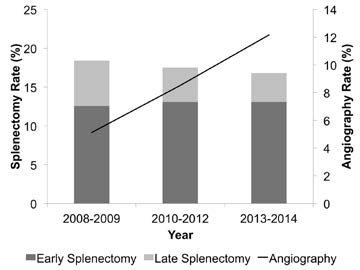The incidence of overwhelming post-splenectomy sepsis, and the need and effectiveness for vaccination after splenectomy is still subject to debate. However, the administration of three vaccines to protect against encapsulated bacteria is a standard of care. For decades, this was a one time thing and the vaccines were usually given before the spelenctomized trauma patient was discharged from the hospital.
Then several years ago, the CDC updated their recommendations to include a booster dose of 23-valent penumococcal vaccine. Trauma professionals have inconsistently advised their patients about this dose, and patients have not reliably sought their booster.
Researchers at Christiana Care in Delaware looked at this potential problem by identifying all of their trauma splenectomy patients over a 10 year period. They were interviewed by phone to determine their understanding of the asplenic state and the need for booster vaccination.
Here are the factoids:
- During the 10 year period, 267 trauma splenectomies were performed
- 196 survived, but only 52 agreed to participate (? – see below)
- Although all patients received vaccines before discharge (!), only 23% were aware that they had
- Only about half of patients were aware that they may be at risk for infectious complications
- Only 19% understood they would require a booster dose, and 22% had actually received one (?? – see below)
Bottom line: Although we still aren’t sure how important these vaccines are, vaccination is the standard of care. This study, although a little confusing, shows that we are falling down in educating our patients about the impact of their splenectomy (surgical or via embolization). And it’s difficult for anyone to remember to get a booster shot. Are you up to date on your tetanus vaccination?
This abstract shows us that we need to counsel these patients prior to discharge regarding their at-risk condition. We also need to make sure they (and their primary care provider) are aware that they need to get a pneumococcal booster five years down the road.
News flash! Take a look at page 3 of the CDC recommendations (download here) to see the official recommendations regarding pneumococcal vaccination. It is recommended that PCV-13 vaccine (Prevnar 13) be given first, then the 23-valent vaccine (Pneumovax) 8 weeks later! This complicates things a bit, since both pneumococcal vaccines cannot be given while the patient is still in the hospital. This will reduce the likelihood that patients will get their second pneumococcal vaccine.
Questions and comments for the authors/presenters:
- The number of patients is off by one. There were 267 splenectomy patients, 49 died in the hospital and 23 after discharge. 267-49-23=195, not 196.
- Only 52 of this 195 agreed to participate. You were able to find all 195? It seems that some of these 143 patients just could not be located.
- Please clarify the numbers in my last bullet point. Of the 52 patients, only 9 were aware of the revaccination requirement, and only 1 got it?
- This is important work. What have you done to improve these numbers at your hospital?
Click here to go the the EAST 2017 page to see comments on other abstracts.
Related posts:
- Complications after spleen embolization
- WBC count after splenectomy
- Platelet count after splenectomy
Reference: Revaccination compliance after trauma splenectomy: a call for improvement. Poster #31, EAST 2017.



